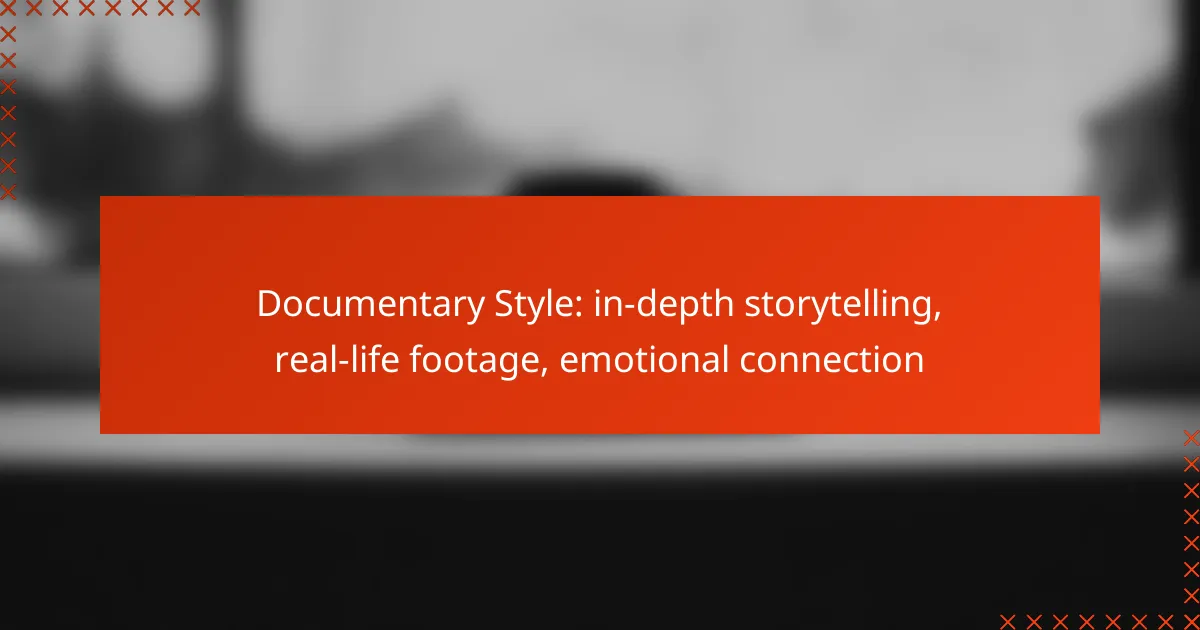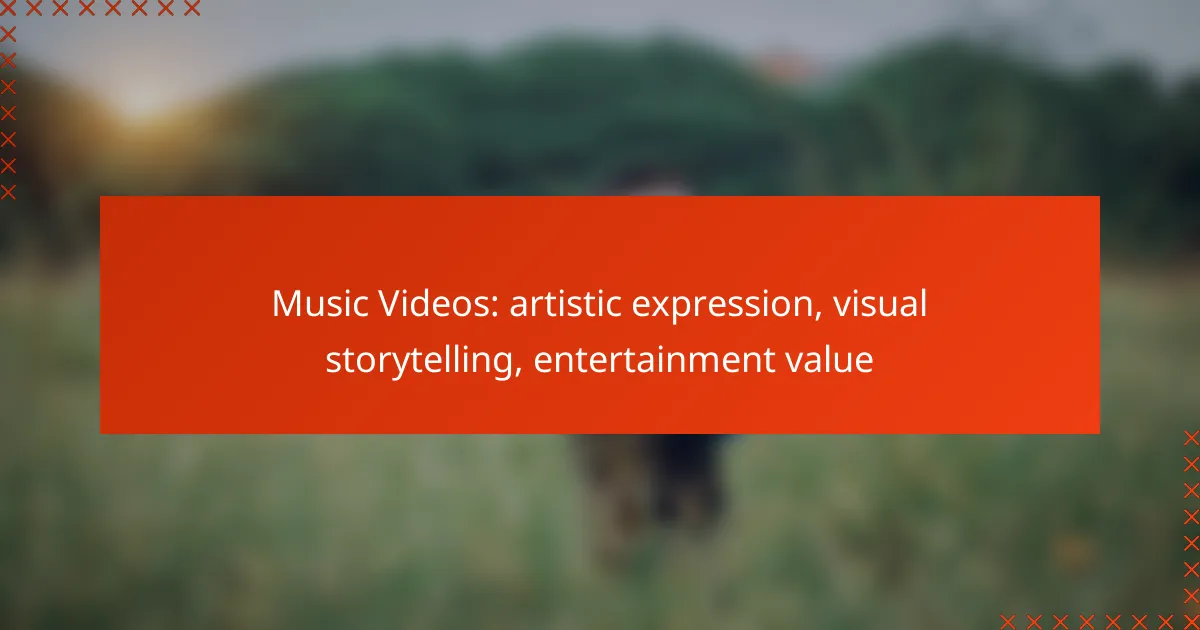Documentary style transforms storytelling by anchoring narratives in real-life experiences and factual events, fostering a profound connection with audiences. By incorporating authentic footage, personal stories, and immersive visual elements, this approach creates an emotional and intellectual resonance that captivates viewers.

How does documentary style enhance storytelling?
Documentary style enhances storytelling by grounding narratives in real-life experiences and factual events, which fosters a deeper connection with the audience. This approach utilizes authentic footage, personal stories, and visual elements to create an immersive experience that resonates emotionally and intellectually.
Real-life footage creates authenticity
Real-life footage is a cornerstone of documentary storytelling, providing viewers with a genuine glimpse into the subject matter. This authenticity helps to build trust, as audiences can see actual events and people rather than staged reenactments. For instance, documentaries about social issues often include interviews and scenes from the lives of individuals affected, making the narrative more relatable and impactful.
When using real-life footage, filmmakers should ensure high-quality visuals and sound to maintain engagement. Poor production quality can detract from the authenticity and diminish the emotional weight of the story. Balancing raw footage with polished editing can enhance the overall experience without losing the essence of reality.
Emotional connection through personal narratives
Personal narratives are powerful tools in documentary storytelling, as they allow viewers to connect with individuals on a human level. By sharing personal stories, filmmakers can evoke empathy and understanding, drawing audiences into the experiences of others. For example, a documentary focusing on a community facing environmental challenges may feature personal accounts that highlight the emotional toll on families and individuals.
To effectively convey emotional connections, filmmakers should focus on storytelling techniques that highlight vulnerability and resilience. Using voiceovers, intimate interviews, and personal artifacts can deepen the viewer’s emotional investment in the narrative. Avoiding overly sensationalized portrayals is crucial; authenticity in storytelling fosters a stronger bond with the audience.
Visual storytelling engages audiences
Visual storytelling is essential in documentaries, as it combines imagery, sound, and narrative to create a compelling experience. Engaging visuals can capture attention and convey complex ideas quickly, making them accessible to a wider audience. For instance, using infographics or animations alongside real footage can help clarify statistics or concepts without overwhelming viewers.
Filmmakers should consider the pacing and composition of visuals to maintain audience interest. Quick cuts, dynamic camera angles, and thoughtful framing can enhance storytelling by emphasizing key moments. However, it’s important to strike a balance; excessive visual effects can distract from the core message and dilute the emotional impact of the story.

What are the key elements of documentary style?
Documentary style relies on several key elements to create engaging narratives that resonate emotionally with viewers. These elements include interviews with real subjects, archival footage and photographs, and natural soundscapes, all of which work together to tell authentic stories.
Interviews with real subjects
Interviews are a cornerstone of documentary style, providing firsthand accounts that add depth and authenticity to the narrative. Filmmakers should focus on selecting subjects who have compelling stories and can articulate their experiences clearly.
When conducting interviews, consider the setting and atmosphere to ensure subjects feel comfortable. This can lead to more genuine responses and emotional connections that resonate with the audience.
Archival footage and photographs
Incorporating archival footage and photographs enriches the storytelling by providing historical context and visual evidence of events. This material can include anything from old news clips to personal photographs that illustrate the subjects’ experiences.
When using archival content, ensure that it is relevant and enhances the narrative. Proper licensing and permissions are crucial to avoid legal issues, especially when using copyrighted material.
Natural soundscapes
Natural soundscapes play a vital role in creating an immersive viewing experience. Sounds from the environment, such as ambient noise, conversations, or music, can evoke emotions and set the tone for the documentary.
Filmmakers should capture high-quality audio during filming and consider layering sound elements in post-production to enhance the atmosphere. Avoid overwhelming the viewer with excessive sound; subtlety often leads to a more powerful impact.

How can filmmakers effectively use documentary style?
Filmmakers can effectively use documentary style by focusing on authentic storytelling, real-life footage, and fostering an emotional connection with the audience. This approach emphasizes the importance of genuine experiences and characters, which resonate deeply with viewers.
Focus on compelling characters
Compelling characters are the heart of any documentary. Filmmakers should seek individuals whose stories evoke strong emotions or highlight significant issues. For instance, a documentary about climate change might feature activists, scientists, and everyday people affected by environmental changes.
To create a strong connection, filmmakers should allow characters to share their personal narratives. This can be achieved through interviews, observational footage, and intimate moments that reveal their struggles and triumphs.
Utilize immersive cinematography
Immersive cinematography enhances the documentary experience by drawing viewers into the story. Techniques such as handheld camera work, close-ups, and natural lighting can create a sense of authenticity. For example, filming in real locations rather than controlled environments helps capture the rawness of the subject matter.
Filmmakers should also consider the pacing and composition of shots. A mix of wide shots to establish context and tight shots to convey emotion can keep the audience engaged and invested in the narrative.
Incorporate expert commentary
Expert commentary adds depth and credibility to a documentary. Including insights from professionals in the relevant field can help contextualize the story and provide viewers with a broader understanding of the issues at hand. This could involve interviews with scientists, historians, or activists who can offer valuable perspectives.
When integrating expert commentary, filmmakers should ensure that it complements the personal stories being told. Balancing emotional narratives with factual information creates a richer viewing experience and encourages critical thinking among the audience.

What are the benefits of documentary style for brands?
Documentary style offers brands a powerful way to connect with audiences through authentic storytelling and real-life footage. This approach fosters a deeper emotional connection, enhancing brand loyalty and trust.
Builds trust and credibility
Using documentary style helps brands establish trust and credibility by showcasing real stories and genuine experiences. When audiences see authentic content, they are more likely to believe in the brand’s message and values.
For example, a brand that shares customer testimonials or behind-the-scenes footage can create a transparent image that resonates with viewers. This authenticity can lead to increased customer loyalty and positive word-of-mouth.
Enhances emotional engagement
Documentary style enhances emotional engagement by tapping into the audience’s feelings and experiences. By presenting relatable stories, brands can evoke empathy and connection, making their message more impactful.
For instance, a brand focused on social issues can use documentary footage to highlight real-life challenges faced by individuals, fostering a sense of shared humanity. This emotional resonance can drive consumers to support the brand’s initiatives and products.
Increases audience retention
Documentary style can significantly increase audience retention by captivating viewers with compelling narratives. Engaging storytelling keeps audiences interested and encourages them to watch until the end.
Brands can leverage this by creating series or episodic content that builds on previous stories, keeping viewers coming back for more. This strategy not only retains attention but also reinforces brand messaging over time.

What are the challenges of documentary filmmaking?
Documentary filmmaking presents several challenges, including the need to balance storytelling with factual accuracy, securing rights for archival materials, and managing production budgets. Each of these aspects requires careful consideration to create a compelling and truthful narrative.
Balancing narrative and factual accuracy
Balancing narrative and factual accuracy is crucial in documentary filmmaking. Filmmakers must weave a compelling story while ensuring that the information presented is truthful and well-researched. This often involves making difficult choices about which facts to emphasize and how to present them without distorting the reality.
To achieve this balance, filmmakers should focus on thorough research and fact-checking. Engaging with experts in the subject matter can provide valuable insights and help maintain credibility. Additionally, using techniques like interviews and real-life footage can enhance the narrative while staying true to the facts.
Securing rights for archival materials
Securing rights for archival materials can be a complex and time-consuming process. Filmmakers often need to obtain permissions for using historical footage, photographs, or audio recordings, which may involve negotiations with various rights holders. This can lead to delays and increased costs if not managed properly.
To streamline this process, filmmakers should start early in the production timeline and create a comprehensive list of all materials needed. Understanding copyright laws and potential fees associated with different types of media can also help in budgeting and planning. Establishing good relationships with archival institutions can facilitate smoother negotiations.
Managing production budgets
Managing production budgets is a significant challenge in documentary filmmaking, where costs can quickly escalate. Filmmakers must account for various expenses, including equipment, crew salaries, travel, and post-production. A well-planned budget is essential to ensure that the project stays financially viable.
To effectively manage budgets, filmmakers should create a detailed budget plan that outlines all anticipated costs. Regularly reviewing and adjusting the budget as the project progresses can help identify potential overspending early on. Seeking funding through grants, crowdfunding, or sponsorships can also provide additional financial support to cover production expenses.

How does documentary style differ across cultures?
Documentary style varies significantly across cultures, shaped by local traditions, storytelling methods, and perspectives on real-life events. Each culture brings its unique lens to documentary filmmaking, influencing how stories are told and received.
Varied storytelling techniques
Different cultures employ distinct storytelling techniques in documentaries, reflecting their values and communication styles. For instance, some cultures may favor a linear narrative that follows a chronological order, while others might embrace non-linear storytelling that weaves together multiple perspectives and timelines.
In many Western documentaries, the use of voice-over narration is common, providing context and guiding the viewer. In contrast, some Eastern cultures might rely more on visual symbolism and ambient sounds to convey meaning, allowing the audience to interpret the story more personally.
Cultural perspectives on real-life events
Cultural perspectives significantly influence how real-life events are portrayed in documentaries. For example, a documentary about a historical conflict might emphasize different heroes or villains depending on the cultural background of the filmmaker and audience. This can lead to varied interpretations of the same event.
Moreover, documentaries from collectivist societies may focus on community experiences and shared narratives, while those from individualistic cultures often highlight personal stories and individual achievements. This difference shapes viewers’ emotional connections to the content.
Influence of local traditions on narratives
Local traditions play a crucial role in shaping documentary narratives, often dictating the themes and subjects that resonate with audiences. For instance, indigenous cultures may incorporate traditional storytelling methods, such as oral histories, to preserve their heritage and convey important messages.
Additionally, cultural rituals and practices can be central to the narrative structure, providing a framework for the documentary. Filmmakers should be mindful of these traditions to ensure respectful and accurate representation, which can enhance the emotional impact of the documentary.



